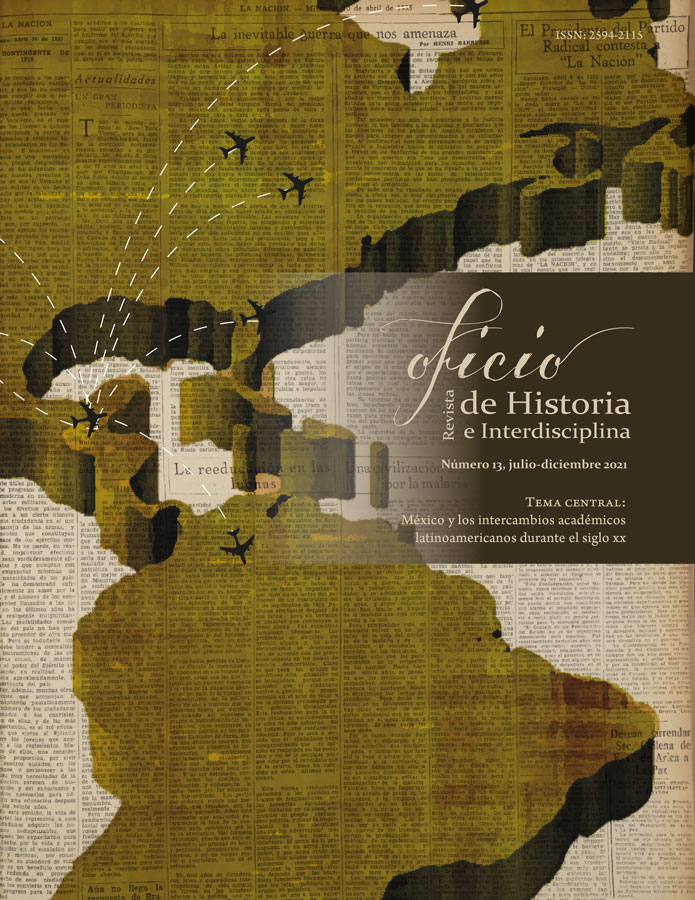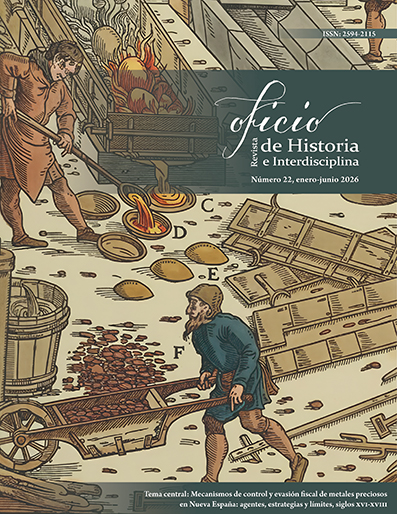De la Tierra sin historia a la historia de la Tierra. El uso de la evidencia geológica en la elaboración y el desarrollo de escalas de tiempo naturalizadas durante los siglos XVII y XVIII
DOI:
https://doi.org/10.15174/orhi.vi13.155Palabras clave:
Escalas de tiempo naturalizadas, medición científica, ciencias históricas, fósiles, estratigrafía.Resumen
El presente artículo es un análisis histórico-filosófico acerca de cómo se fueron desarrollando las principales ideas conceptuales, epistemológicas, metodológicas, así como los recursos cognitivos que permitieron plantear por primera vez en la ciencia moderna que la Tierra tenía una historia propia e independiente a la historia humana. Mi argumento es que el estudio de los fósiles y el de los estratos geológicos llevaron a la formulación de nuevas e inéditas ideas acerca de los procesos de transformación geológica y de fosilización en los siglos XVII y XVIII. La investigación de este segmento del mundo natural fue el antecedente que permitió establecer las primeras condiciones de posibilidad para que en el siglo XIX se aceptara que la edad de la Tierra era más antigua que el cálculo basado en las cronologías bíblicas, lo cual representó un nuevo problema métrico para las nacientes ciencias históricas, como la geología, la paleontología, la arqueología y la biología evolutiva: ¿Cuál es la edad de la Tierra y cómopodemos calcularla?
Descargas
Citas
FUENTES
Bibliográficas
Adams, Frank Dawson, The Birth and Development of the Geological Sciences, Nueva York: Dover, 1954.
Agricola, Georgius, De Natura Fossilium, Nueva York: Dover Phoenix Editions, 2013 (1.a ed. 1546).
________________, De Re Metallica (traducción de Herbert Clark Hoover y Lou Henry Hoover), 1950 (1.ª ed. 1556), versión digital en: <https://www.gutenberg.org/files/38015/38015-h/38015-h.htm>.
Barr, James, “Why the World Was Created in 4004 B.C.: Archbishop Ussher and Biblical Chro-nology”, en: A lecture delivered in the John Rylands University Library of Manchester, 1984, pp. 575-609.
________________, “Pre-Scientific Chronology: The Bible and the Origin of the World”, en: Proceedings of the American Philosophical Society, vol. 143, núm. 3, 1999, pp. 379–387.
Burnet, Bishop, History of His Own Time, Libro I, cap. V, Londres, 1753.
Chang, Hasok, Inventing Temperature: Measurement and Scientific Progress, (col. Oxford Studies in Philosophy of Science), Nueva York: Oxford University Press, 2004.
Cutler, Alan H., The Seashell on the Mountaintop: A Story of Science, Sainthood, and the Humble Genius Who Discovered a New History of the Earth, Nueva York: Dutton (Penguin), 2003.
________________, “Nicolaus Steno and the Problem of Deep Time”, en: The Revolution in Geology from the Renaissance to the Enlightenment, editado por Gary D. Rosenberg, Estados Unidos: Geological Society of America, 2010, pp. 143-148.
Del Razo,Carlo, “Un análisis histórico-filosófico acerca de la medición del tiempo en las cronologías bíblicas”, en: Revista Valenciana, núm. 23, enero-junio de 2019, pp. 227-263.
Gaukroger, Stephen, The Emergence of a Scientific Culture Science and the Shaping of Modernity 1210-1685, Nueva York: Oxford University Press, 2006.
Goodrum, Matthew R ., “Questioning Thunderstones and Arrowheads: The Problem of Recognizing and Interpreting Stone Artifacts in the Seventeenth Century”, en: Early Science and Medicine, vol. 13, núm. 5, 2008, pp. 482-508.
Gould, Stephen J., Time’s Arrow. Time’s Cycle, Cambridge: Harvard University Press, 1987.
________________, “Father Athanasius on the Isthmus of a Middle State: Understanding Kircher’s Paleontology”, en: Athanasius Kircher: The Last Man Who Knew Everything, (edición de Paula Findlen), Londres: Rout-ledge, 2004, pp. 207-238.
________________, The Lying Stones of Marrakech: Penultimate Reections in Natural History, Cambridge: Harvard University Press, 2011.
Guillaumin, Godfrey, El surgimiento de la noción de evidencia. Un estudio de epistemología histórica sobre la idea de evidencia científica, México: UNAM, Programa Editorial de Coordinación de Humanidades, 2005.
________________, Raíces metodológicas de la teoría de la evolución de Charles Darwin, México: Antrophos-UAM, 2009.
________________, “De las cualidades a las magnitudes: la integración cognitiva de la medición en el surgimiento de la astronomía moderna”, en: Signos Filosóficos, vol. 14, núm. 28, julio-diciembre 2012, pp. 57-89.
________________, Génesis de la medición celeste. Una historia cognitiva del crecimiento de la medición científica, México: UAM-I y Tirant Humanidades, 2016.
Hooke, Robert, Micrographia, en: The Project Gutenberg eBook, 1665, version digital en: <https://www.gutenberg.org/files/15491/15491-8.txt> (consultado el 18 de noviembre de 2019).
________________, The Posthumous Works of Robert Hooke (edición de R . Waller), London, 1705.
Kitcher, Philip, The Advancement of Science: Science without Legend, Objectivity without Illusions, Nueva York: Oxford University Press, 1993.
Kuhn, Thomas, La Estructura de las Revoluciones Científicas, México: Fondo de Cultura Económica, 2006.
Laudan, Larry, Progress and Its Problems: Toward a Theory of Scientific Growth, (ed. Routledge and Kegan Paul), Berkeley: University of California Press, 1977.
Lesne, Annick, “Time Variable and Time Scales in Natural Systems and Their Modeling”, en: Christophe Bouton y Philippe Huneman (eds.), Time of Nature and the Nature of Time. Philosophical Perspectives of Time in Natural Sciences, (col. Boston Studies in the Philosophy and History of Science), Cham: Springer, 2017, pp. 55-66.
Lyell, Charles, Principles of Geology(1830-33), Estados Unidos: Chicago Press, 1990.
________________, The Geological Evidences of the Antiquity of Man, (edición de John Murray), London: ltd, 1863.
_________________,The Geological Evidences of the Antiquity of Man, Londres, 1863, versión digital en: <https://archive.org/details/geologicaleviden00lyelrich> (consultado el 18 de noviembre de 2019).
Nothaft, C., “Noah’s Calendar: The Chronology of The Flood Narrative and the History of Astronomy in Sixteenth and Seventeenth-Century Scholarship”, en: Journal of the Warburg and Courtauld Institutes, núm. 74, 2011, pp. 191-211.
Richet, Pascal, A Natural History of Time, Estados Unidos: The University of Chicago Press, 2007.
Rudwick, Martin J. S., Bursting the Limits of Time: The Reconstruction Of Geohistory In The Age Of Revolution, Estados Unidos: The University of Chicago Press, 2005.
________________, Worlds Before Adam: The Reconstruction of Geohistory In the Age of Reform, Estados Unidos: The University of Chicago Press, 2008.
________________, Earth’s Deep History: How It Was Discovered and Why It Matters, Estados Unidos: The University of Chicago Press, 2014.
Sissingh, W., Rocky Roads from Firenze: History of Geological Time and Change 1650-1900, Países Bajos: Utrecht Studies in Earth Sciences, 2012.
Sober, Elliott, Reconstructing the Past Parsimony, Evolution, and Inference, (col. Bradford Books), Massachusetts: The mit Press, 1988.
Steno, Nicolaus, The prodromus of Nicolaus Steno’s dissertation concerning a solid body enclosed by process of nature within a solid; an English version with an introduction and explanatory notes, Londres: Macmillan And Company, 1916 (1.a ed. 1668).
________________, “Of time and change. Strata of the Earth”, en: Man’s Discovery of his Past (1969), Robert Heizer Ed., Peek Publications, 1669, s/p.
Wallraff, Martin, Iulius Africanus Chronographiae, Berlin/Nueva York: Walter de Gruyter, 2007.
Wilcox, Donald, The Measure of Times Past. Pre-Newtonian Chronologies and The Rhetoric of Relative Time, Estados Unidos: The University of Chicago Press, 1987.
Publicado
Cómo citar
Número
Sección
Licencia
Derechos de autor 2021 Carlo Del Razo Canuto

Esta obra está bajo una licencia internacional Creative Commons Atribución-NoComercial 4.0.
Al momento en que Oficio acepte la publicación de un artículo, el autor firmará una carta de autorización para que la revista pueda realizar la edición, reproducción, divulgación, publicación, distribución y/o comunicación pública del texto, con acceso libre y gratuito en la publicación periódica en comento, tanto en su versión impresa (identificada con el número ISSN 2448-4717), en su versión electrónica (identificada con el ISSN número 2594-2115), y su almacenamiento y divulgación en otros medios, por ejemplo el Repositorio Institucional de la Universidad de Guanajuato. El autor hace la autorización de forma gratuita y no exclusiva, conservando los derechos patrimoniales y morales sobre su obra.






